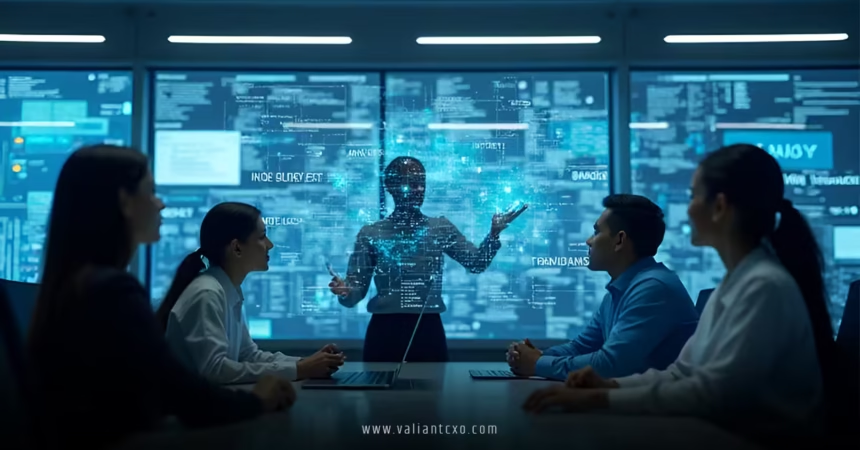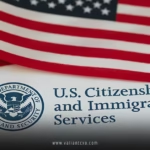US Government Initiatives for AI Workforce Development are shaping the future of work in an era where artificial intelligence (AI) is no longer a sci-fi dream but a cornerstone of innovation. Imagine a world where machines think, learn, and solve problems alongside humans—pretty exciting, right? But here’s the catch: to thrive in this AI-driven landscape, America needs a workforce equipped with the right skills. That’s where the US government steps in, rolling out bold strategies to prepare workers for the jobs of tomorrow. In this article, we’ll dive deep into how these initiatives are paving the way for a tech-savvy, AI-ready workforce. From policy frameworks to training programs, let’s explore what’s happening and why it matters.
Why US Government Initiatives for AI Workforce Development Matter
Picture this: a factory worker in Ohio, a teacher in California, and a coder in Texas all need to adapt to AI’s rapid rise. Why? Because AI is transforming industries faster than you can say “machine learning.” From healthcare to defense, agriculture to education, AI is reshaping how we work. But without the right skills, workers risk being left behind. That’s why US Government Initiatives for AI Workforce Development are critical—they’re the bridge between today’s workforce and tomorrow’s opportunities.
These initiatives aren’t just about teaching people to code or understand algorithms. They’re about fostering AI literacy, empowering educators, and creating pathways for everyone—youth, adults, and even dislocated workers—to thrive in an AI-powered economy. By investing in training, research, and partnerships, the government aims to maintain America’s edge in global AI leadership while ensuring no one gets left out. So, what exactly is the government doing? Let’s break it down.
Key Policies Driving US Government Initiatives for AI Workforce Development
The National AI Initiative Act of 2020: A Foundation for Growth
US Government Initiatives for AI Workforce Development : Back in 2020, the US government laid a cornerstone for AI advancement with the National AI Initiative Act. Think of it as a blueprint for building a house—solid, strategic, and forward-thinking. This act, part of the National Defense Authorization Act, set the stage for coordinated AI research, development, and workforce training. It sparked the creation of National AI Research Institutes, with a $140 million investment in 2023 to fund seven new institutes focused on ethical AI, cybersecurity, and workforce diversity.
These institutes aren’t just ivory towers for academics. They’re hubs for training the next generation of AI experts, from coders to policymakers. By emphasizing responsible innovation, the act ensures that US Government Initiatives for AI Workforce Development prioritize both technical skills and ethical considerations. It’s like teaching someone to drive a car while also instilling the importance of following traffic rules—both are essential for a smooth ride.
Executive Orders: Steering the AI Ship
Fast forward to 2025, and the government’s commitment to AI workforce development is stronger than ever. Executive orders under multiple administrations have kept the momentum going. For instance, President Trump’s 2019 Executive Order 13859, “Maintaining American Leadership in AI,” emphasized workforce training to keep the US competitive. Later, President Biden’s 2023 Executive Order 14110 focused on safe and trustworthy AI, directing agencies to develop training programs for federal employees to responsibly use AI.
In 2025, another executive order, “Advancing United States Leadership in Artificial Intelligence Infrastructure,” highlighted the need for a skilled workforce to support AI infrastructure, like data centers and semiconductor manufacturing. These orders are like a captain steering a ship—each one adjusts the course to ensure America stays ahead in the global AI race.
Programs Fueling AI Skills Development
Workforce Innovation and Opportunity Act (WIOA): A Game-Changer
US Government Initiatives for AI Workforce Development : Ever wondered how the government helps workers pivot to new careers? Enter the Workforce Innovation and Opportunity Act (WIOA). In August 2025, the Department of Labor issued guidance encouraging states to use WIOA grants to boost AI literacy. This isn’t just about throwing money at the problem—it’s about empowering local workforce boards to create tailored programs for youth, adults, and dislocated workers.
Imagine a laid-off factory worker in Pittsburgh learning to analyze AI-driven traffic systems or a high school student in Atlanta gaining AI skills through a summer program. WIOA funds make this possible by supporting work-based learning, apprenticeships, and AI-focused training. It’s like giving workers a toolbox filled with the latest gadgets to tackle the AI economy.
AI Training Act: Preparing for Global Competition
Signed into law in October 2022, the AI Training Act is a bold move to keep America ahead of global rivals like China. This act pushes for more AI training opportunities for government employees and civilians alike. It’s like planting seeds for a future forest of AI talent—nurturing skills today that will bloom into innovation tomorrow. By focusing on high-priority occupations critical to AI infrastructure, the act ensures that US Government Initiatives for AI Workforce Development are laser-focused on strategic needs.
Partnerships and Collaborations: The Power of Teamwork
Public-Private Partnerships: Bridging the Gap
US Government Initiatives for AI Workforce Development : The government knows it can’t do this alone. That’s why US Government Initiatives for AI Workforce Development lean heavily on partnerships with industry giants like Google, Amazon, and Microsoft. For example, Google’s “AI Works for America” initiative, launched in July 2025, targets Pittsburgh as a pilot city for free AI training. By collaborating with libraries, community colleges, and nonprofits, this program brings AI skills to workers and small businesses.
These partnerships are like a potluck dinner—everyone brings something to the table. Industry provides cutting-edge tools and expertise, while the government offers funding and infrastructure. Together, they create a feast of opportunities for workers to upskill and thrive.
Academic Alliances: Educating the Next Generation
Universities and research institutes are also key players. The National Science Foundation (NSF) and the Department of Energy (DOE) are teaming up with academic institutions to develop AI curricula and training programs. For instance, the DOE’s VoltAIc Initiative uses AI to streamline clean energy projects, creating demand for skilled workers. Meanwhile, NSF-funded AI Research Institutes are training students in everything from AI ethics to machine learning.
Think of these alliances as a relay race—academia passes the baton of knowledge to students, who then carry it into the workforce. This ensures a steady pipeline of AI talent ready to tackle real-world challenges.
Focus Areas of US Government Initiatives for AI Workforce Development
AI Literacy for All: From K-12 to Lifelong Learning
US Government Initiatives for AI Workforce Development : What if every American, from kindergartners to retirees, could understand AI? That’s the vision behind initiatives like the 2025 Executive Order on Advancing AI Education for American Youth. This order pushes for AI literacy in K-12 schools, teacher training, and lifelong learning programs. By integrating AI concepts into classrooms, the government aims to demystify technology and spark curiosity.
Imagine a fifth-grader learning to code a simple chatbot or a teacher using AI to personalize lesson plans. These efforts aren’t just about tech—they’re about empowering people to think critically and creatively in an AI-driven world.
Empowering Federal Employees: Leading by Example
The government isn’t just training civilians—it’s upskilling its own workforce. The General Services Administration (GSA) launched an expanded AI Training Series in 2024, offering courses on AI procurement, leadership, and technical skills. Delivered by top institutions like Stanford and Princeton, these programs ensure federal employees can responsibly integrate AI into their work.
It’s like teaching a chef to use a new kitchen gadget—once they master it, they can whip up better results faster. By equipping its workforce with AI know-how, the government sets a standard for the private sector to follow.
Supporting Underserved Communities: Equity in AI
AI shouldn’t be a privilege for the few—it should lift everyone up. US Government Initiatives for AI Workforce Development prioritize diversity and inclusion. Programs like the NSF’s AI Research Institutes focus on building a diverse workforce, ensuring underrepresented groups have access to AI training.
Picture a single mom in a rural community learning AI skills through a WIOA-funded program or a veteran transitioning to a tech career via an apprenticeship. These initiatives are like opening doors to rooms that were once locked, giving everyone a chance to succeed.
Challenges and Opportunities in AI Workforce Development
The Skills Gap: A Hurdle to Overcome
Let’s be real—there’s a gap between the skills workers have and what AI jobs demand. The US produces fewer STEM graduates than some competitors, and visa restrictions can make it hard to retain global talent. US Government Initiatives for AI Workforce Development are tackling this by expanding STEM education and creating pathways for international experts, like the proposed National Security AI Entrepreneur Visa.
It’s like fixing a leaky pipe—you need to plug the holes (skill shortages) while increasing the flow (training opportunities). The government’s multi-pronged approach aims to do just that.
Balancing Speed and Ethics
AI moves fast, but ethics can’t be an afterthought. Initiatives like the NIST AI Risk Management Framework ensure that workforce training includes ethical considerations. Workers aren’t just learning to build AI systems—they’re learning to build them responsibly, avoiding biases and protecting privacy.
Think of it as teaching a kid to ride a bike with training wheels—speed is great, but safety comes first. By embedding ethics into training, the government ensures AI serves the public good.
The Future of US Government Initiatives for AI Workforce Development
What’s next for US Government Initiatives for AI Workforce Development? The future looks bright but busy. Plans like the 2025 AI Action Plan outline ambitious goals: more apprenticeships, expanded AI education, and streamlined regulations to boost innovation. The Department of Labor’s “America’s Talent Strategy” report emphasizes preparing workers for high-demand AI roles, while the DOE’s FASST initiative aims to lead in trustworthy AI development.
Imagine a future where AI skills are as common as knowing how to use a smartphone. That’s the goal—a workforce that’s not just ready for AI but leading the charge. By investing in education, partnerships, and innovation, the government is laying the groundwork for a new era of prosperity.
Conclusion: A Call to Embrace the AI Future
US Government Initiatives for AI Workforce Development are more than just policies—they’re a roadmap to a future where every American can thrive in an AI-driven world. From the National AI Initiative Act to WIOA-funded programs, the government is pulling out all the stops to build a skilled, diverse, and ethical workforce. These efforts are like planting a garden: with the right care, they’ll yield a harvest of innovation, opportunity, and global leadership. So, whether you’re a student, a worker, or an educator, now’s the time to jump in, learn, and shape the future. The AI revolution is here—let’s make it work for everyone.
FAQs About US Government Initiatives for AI Workforce Development
What are the main goals of US Government Initiatives for AI Workforce Development?
The initiatives aim to build AI literacy, create training programs, and ensure a diverse, skilled workforce to maintain America’s global AI leadership while promoting ethical AI use.
How does the Workforce Innovation and Opportunity Act support AI training?
WIOA funds programs for youth, adults, and dislocated workers, encouraging states to prioritize AI literacy and skills training through local workforce boards.
Who benefits from US Government Initiatives for AI Workforce Development?
Everyone from K-12 students to federal employees, underserved communities, and workers transitioning to AI-related careers can access training and opportunities.
How do public-private partnerships enhance AI workforce development?
Collaborations with companies like Google and universities provide resources, expertise, and real-world training, amplifying the impact of US Government Initiatives for AI Workforce Development.
For More Updates !! : valiantcxo.com


